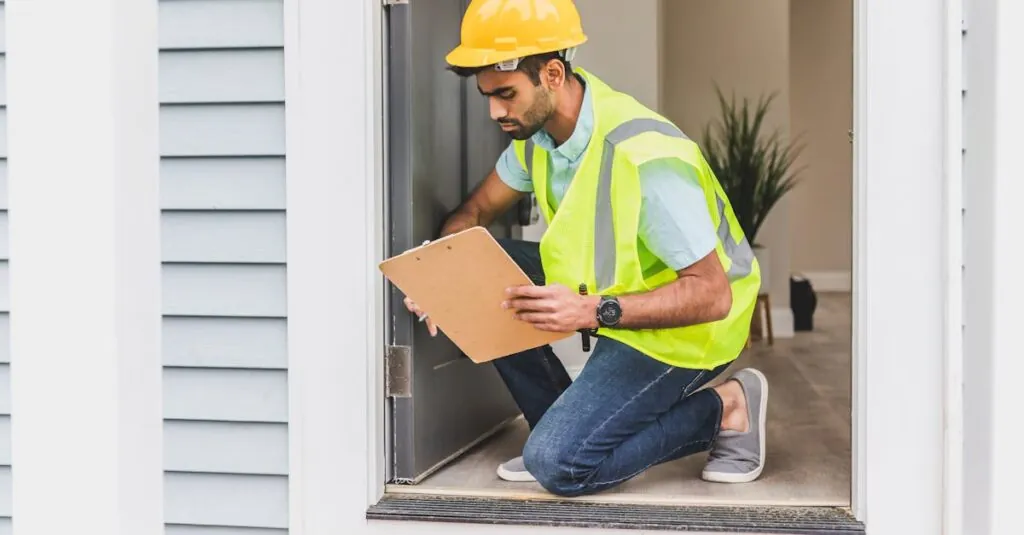A garage door might not be the star of your home, but it plays a leading role in your daily life. Imagine your life without it—no quick escapes for coffee runs or late-night returns without a hassle. Keeping that unsung hero in tip-top shape is crucial. Enter the garage door maintenance checklist, your new best friend in avoiding costly repairs and unexpected surprises.
Importance Of Garage Door Maintenance
Regular garage door maintenance enhances safety and security. A well-maintained door minimizes risks of accidents and injuries. Annual inspections can catch potential issues early. These proactive measures prevent costly repairs.
Energy efficiency benefits homeowners significantly. Insulated garage doors reduce heating and cooling costs. Maintaining weather seals keeps the garage climate-controlled. This step contributes to a more comfortable home environment.
Garage doors also add value to properties. Curb appeal increases with well-maintained doors. Prospective buyers appreciate functional and attractive features. Investing in maintenance leads to a better return on investment.
Frequent maintenance extends the lifespan of garage doors. Proper lubrication of moving parts reduces wear and tear. Monitoring springs and cables ensures optimal performance. Attention to detail pays off through increased durability.
Monitoring the garage door’s functionality is essential. Identifying unusual noises or movements signals underlying issues. Responsive maintenance allows detection before problems escalate. Timely repairs save time and prevent stress.
Homeowners experience peace of mind with reliable garage doors. Knowing the door functions correctly protects vehicles and belongings. Consistent upkeep enhances overall enjoyment of the garage space. Emphasizing maintenance fosters a long-lasting, functional investment.
Essential Tools For Garage Door Care
Maintaining a garage door requires specific tools that ensure effective upkeep. Homeowners benefit from having the right equipment at hand.
Basic Tools Needed
A cordless drill facilitates easy removal and attachment of parts. A socket set provides the necessary sizes for nuts and bolts. Screwdrivers in various types allow for adjustments and repairs. Pliers handle gripping and twisting components effectively. Moreover, a level confirms proper alignment during installations or adjustments. Each tool plays a crucial role in routine maintenance and repair tasks.
Safety Equipment
Safety goggles protect eyes from debris and metal fragments. Work gloves safeguard hands while handling sharp or heavy parts. A sturdy ladder ensures safe access to higher components without risk. Hearing protection becomes important during noisy tasks or when using power tools. Lastly, a first aid kit on-site provides peace of mind in case of unexpected injuries. Prioritizing safety prevents accidents and ensures a smooth maintenance process.
Routine Maintenance Tasks
Routine maintenance tasks ensure the garage door operates smoothly and safely. Following this checklist helps prevent costly repairs and prolongs the lifespan of the door.
Visual Inspections
Visual inspections identify any visible signs of wear and tear. Check the door for dents, cracks, or rust that may compromise structural integrity. Inspect hardware such as springs, cables, and rollers for signs of wear. Pay attention to the alignment of tracks, as misalignment may cause operational issues. Regular visual checks can catch small problems before they escalate, ensuring safe usage.
Lubrication
Lubrication keeps moving parts functioning properly. Apply a silicone-based lubricant to rollers, hinges, and tracks to minimize friction. Regularly lubricating these components helps reduce noise and ensures smooth operation. Lubricate the door’s spring every six months to prevent rust and prolong its lifespan. Following this practice enhances performance and extends the time between more extensive maintenance.
Cleaning Procedures
Cleaning procedures contribute to the door’s appearance and functionality. Use a mild detergent and a soft cloth to clean the door’s surface, removing dirt and debris. Don’t forget to clean the tracks to ensure smooth movement and prevent obstructions. Clear any buildup around seals to maintain optimal insulation. Effective cleaning enhances curb appeal and supports the overall performance of the garage door.
Seasonal Maintenance Tips
Seasonal maintenance enhances the longevity and functionality of garage doors. Homeowners should follow specific guidelines during summer and winter to keep their garage doors in peak condition.
Summer Preparations
During summer, heat can cause garage door components to expand. Inspecting the door for warping or misalignment prevents issues from escalating. Lubrication should occur more frequently, as increased humidity and heat can amplify wear on parts like rollers and hinges. Cleaning the garage door with a mild detergent helps maintain its appearance while removing grime that can affect functionality. Additionally, testing the automatic opener ensures it responds promptly, as summer storms can lead to power outages.
Winter Considerations
In winter, cold temperatures can affect the garage door’s performance. Homeowners must clear snow and ice from tracks and sensors to prevent jams. Regular checks for signs of rust or corrosion on metal parts are crucial for ensuring smooth operation. Using a silicone-based lubricant, rather than petroleum-based options, helps maintain mobility in cold conditions. Sealing any gaps around the door minimizes drafts, enhancing energy efficiency and preventing heat loss. Lastly, ensuring the door opens and closes smoothly protects vehicles and belongings from harsh winter weather.
Troubleshooting Common Issues
Homeowners may encounter various issues with their garage doors. Identifying and addressing these problems quickly enhances functionality and safety.
Noisy Door Problems
Noisy garage doors can disrupt daily life. First, check for loose hardware. Bolts or screws may need tightening, which can eliminate rattling sounds. Secondly, inspect the rollers and hinges for wear. Replacing worn components significantly reduces noise levels. Additionally, lubrication plays a key role in ensuring smooth operation. Use a silicone-based lubricant on rollers and tracks to minimize friction. Unusual grinding sounds often indicate issues with the opener itself. A check-up on opener settings may resolve this problem.
Door Not Opening/Closing
A garage door not opening or closing can cause inconvenience. Start by examining the remote batteries; dead batteries often lead to malfunction. If the remote works, inspect the safety sensors located at the bottom of the door tracks. Clear any obstructions blocking the sensors to restore functionality. Check the power supply to the garage door opener. If it’s unresponsive, ensure that it’s plugged in and circuit breakers are functioning properly. Additionally, manual operation can be tested. Lifting the door manually will help identify stiffness or misalignments that might require adjustment or further inspection.
Conclusion
Regular garage door maintenance is essential for safety and efficiency. By following the maintenance checklist, homeowners can ensure their garage doors function smoothly and last longer. This proactive approach not only prevents costly repairs but also enhances the overall value and appeal of the property.
Investing time in routine inspections and upkeep helps identify potential issues early, providing peace of mind. With the right tools and safety measures in place, maintaining a garage door becomes a manageable task that pays off in the long run. Keeping garage doors in top shape ensures they continue to protect vehicles and belongings while adding convenience to daily life.





